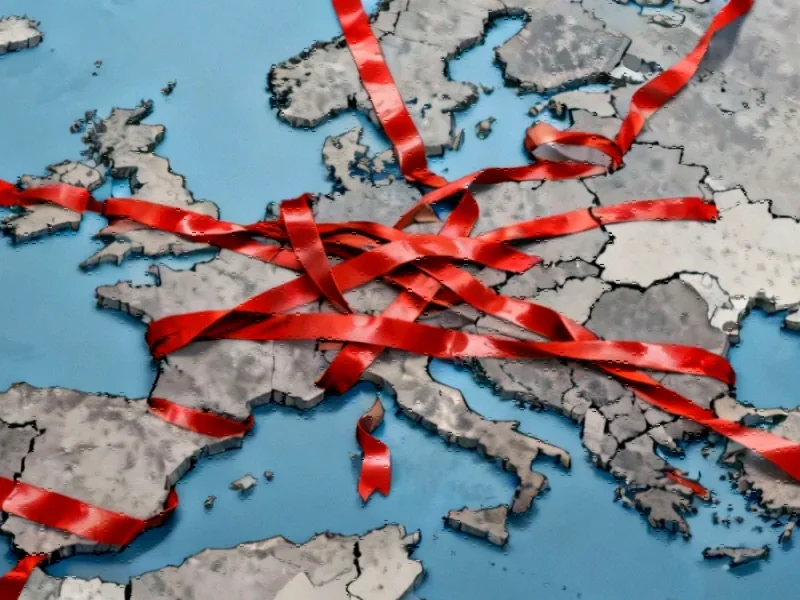Financial Regulation Clash Threatens European Competitiveness
Marc Rowan, CEO of Apollo Global Management, has delivered a stark assessment of Europe’s financial landscape, describing a continent “at war with itself” over regulatory approaches. The private equity leader’s comments highlight the growing tension between political ambitions for economic growth and regulatory frameworks that may inadvertently stifle investment and innovation.
Speaking at the Financial Times private capital summit, Rowan emphasized that Europe’s excessive financial regulation is undermining its competitiveness relative to the United States. “On the political side, you have all the signals of embracing risk-taking, equitisation and private markets,” he noted. “[But] on the regulatory side, not so much.”
The Capital Imperative for European Sovereignty
Rowan’s critique comes at a critical juncture for European economies seeking to maintain technological sovereignty. European businesses and governments are increasingly turning to private capital groups to bolster their technology sectors and infrastructure. “They do not want to be a technology colony,” Rowan observed. “They want to be leaders—they want to actually have their own infrastructure, their own defence base, their own everything.”
This push for technological independence aligns with broader industry developments in global infrastructure investment. Apollo has already demonstrated this commitment through significant financing of major projects, including Intel’s semiconductor fabrication plant in Ireland and EDF’s Hinkley Point C nuclear power station in the UK.
Private Capital’s Growing European Footprint
Despite regulatory challenges, private capital firms are planning substantial increases in European investment over the coming decade. Apollo and its competitors—including Blackstone, KKR, and Brookfield—recognize the region’s untapped potential. Rowan projects that “on a relative basis, Europe will grow faster than the US with respect to private capital because it needs it more.”
This investment surge comes as European leaders grapple with productivity challenges identified in Mario Draghi’s landmark competitiveness report. The former ECB president warned of an “existential challenge” if the continent fails to address its productivity gap, outlining nearly 400 recommendations for improvement.
Global Context: Regulatory and Fiscal Challenges
Rowan’s criticism extends beyond European borders, addressing fiscal concerns in the United States as well. Despite previous consideration for Treasury secretary under President Trump, Rowan stated the administration had “absolutely not” made progress on addressing the US debt or deficit. “The willingness of politicians in the US, and I would say [in the UK], and in Europe, and in almost every western democracy, to do something fundamental outside of crisis is nil,” he remarked.
These fiscal challenges parallel concerns about Europe’s regulatory climate and its impact on economic competitiveness. As Rowan noted, “Every problem that we have in the US is worse here [in Europe], every single problem.”
Technology Infrastructure and Security Considerations
The push for European technological sovereignty occurs against a backdrop of increasing global cybersecurity concerns. Recent global cybersecurity tensions highlight the importance of secure, domestically controlled infrastructure. Private capital’s role in funding critical projects extends beyond economic considerations to encompass national security implications.
Meanwhile, technology companies continue to navigate their own challenges, as evidenced by Windows 11 updates and the ongoing need for system improvements. These critical updates demonstrate how even established technology platforms require continuous investment and refinement—a parallel to the broader infrastructure needs facing European economies.
Risk Management in an Uncertain Landscape
As private capital flows into European infrastructure, effective risk management becomes increasingly crucial. The transformation of data center risk through SLA insurance represents just one example of how innovative financial instruments can support large-scale technology investments.
The involvement of major technology leaders in global discussions, including Nvidia’s Jensen Huang engaging with global leaders, underscores the interconnected nature of technology investment, regulation, and economic competitiveness. These related innovations in both technology and finance will likely shape Europe’s ability to attract the capital needed for its ambitious transformation.
Path Forward: Balancing Regulation and Growth
Rowan’s comments highlight a critical dilemma for European policymakers: how to maintain appropriate financial safeguards while enabling the risk-taking and investment necessary for economic vitality. The substantial capital requirements for achieving technological sovereignty—from semiconductor manufacturing to energy infrastructure—will test this balance.
As European leaders consider Draghi’s competitiveness recommendations and navigate market trends in private capital flows, the region’s ability to resolve its “war with itself” over financial regulation may determine its economic trajectory for decades to come. The coming years will reveal whether Europe can create a regulatory environment that protects stability while enabling the growth and innovation needed to compete globally.
This article aggregates information from publicly available sources. All trademarks and copyrights belong to their respective owners.
Note: Featured image is for illustrative purposes only and does not represent any specific product, service, or entity mentioned in this article.


